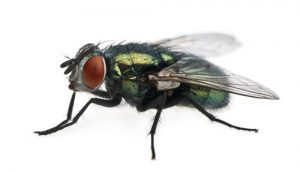Blow Flies & Carcasses
By Chris Williams on July 20, 2011.
Q. In the last week, we have seen at least a dozen large, metallic green flies in our kitchen. They’re a little bigger than a house fly and they buzz and fly into the window. Any idea what they are and how they got there?
A. The flies sound like they could be blow flies (also called greenbottle flies) but why they’re there is a bit more difficult. The greenbottle flies and the very similar bluebottle (metallic blue) flies are primarily scavengers, laying their eggs on animal flesh and animal waste. They typically breed outside and can be serious pests around dumpsters, barns, kennels, poultry houses, meat processing plants, landfills, etc. If you live near one of these sites, the flies could be coming in from outside. Or they could be accidentally flying in from pet feces or a dead animal outside, but since you have seen several, it’s a good bet that they are coming from inside.
I know you’re saying, “but I don’t have animal flesh or animal waste in my kitchen!” You may though and not realize it. The number one source of blow flies in a home is a dead animal, usually in a wall void or nearby garage, attic, chimney, or crawlspace. Usually that dead animal is a rodent, often as a result of residents putting out toxic bait. But other possibilities are dead birds, bats, or squirrels that have been nesting in or on the house or have become trapped inside.
Blow flies have great “noses” for death and can sniff out an animal within 20 minutes of its death. If a female blow fly detects a dead animal in your attic for example, she will find some way to get into the attic and get to the carcass. She immediately lays up to 180 eggs on the carcass and the larvae hatch within hours. After feeding on the carcass for about a week, the fly larvae pupate and emerge as adult flies.
If a dead animal is ruled out, other possible sources of blow flies inside a home are accumulated pet feces, wet, rotting garbage that may have been overlooked, decaying fruit or vegetables, and raw or decaying meat or fish. I know a great true story about a blow fly infestation: An elderly woman had ordered several packages of meat for her freezer. When it was delivered, she told the guy to just set the packages in the basement by the freezer and she would put them in later. Then she forgot. About two weeks later, she was inundated with blow flies throughout her house. A pest control operator finally found the source of the flies (using his nose) in the basement where what was left of the meat was oozing on the workbench!
Because you’re seeing the blow flies in your kitchen, it’s most likely that the source is in the kitchen or very nearby. It’s also possible that the flies are just ending up in the kitchen by following food smells.
Like house flies, blow flies can mechanically transmit certain diseases to people after feeding on an infected animal or after walking over garbage, sewage, or feces. If the fly larvae are accidentally swallowed in food, they can survive inside the human intestine, causing great pain. You don’t want that in your kitchen!
Finding the source of the blow flies is just the first part of the solution. Once the fly source has been found, you need to remove that source and figure out how to prevent it from happening again. If you have mice or other animals sharing your home, you obviously need to get rid of them and then seal up entry points that are letting them in. Colonial’s experts can help. We do it all! – fly control, animal control, and pest-proofing your home. Give us a call today!